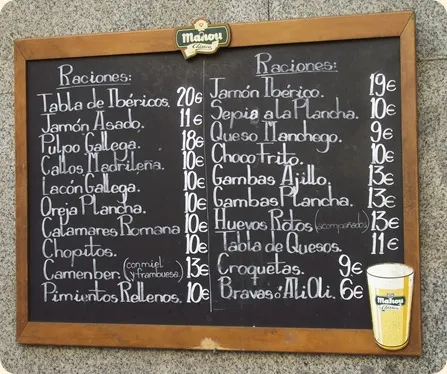Wine was the magnet that drew me 4,000 miles from Ohio to Spain – but it was the food that made the trip an unforgettable experience.
Wandering the Streets of Madrid
As I stepped into Adolfo Suárez Madrid–Barajas Airport’s Terminal 4, I was impressed with the architectural look. It is Europe’s sixth busiest airport and I hadn’t expected the design to be so striking.
For my transfer to the Hotel Miguel Angel I was joined by two colleagues who were also taking part in the press trip hosted by Ferrer Family Wines. We remained somewhat groggy, but determined we needed to head out to have some tapas for lunch.
Casual Eats Trump The Formal Option
Sunday in Spain is a family day. Families typically take a walk together and have a sit down lunch. The Spanish love to eat at outdoor cafés and were doing so despite temperatures around 50 degrees Fahrenheit. On our Sunday stroll, tapas was what we were looking for.
A Royal Origin of Tapas
As tabernas adjusted to this ruling, they served wine covered with a slice of smoked cheese or ham. It became the perfect food to keep Spaniards fueled until their notoriously late dinners. Dinner usually begins at 9:00 PM, but reservations as late as 11:00 PM are not unusual.
A Love Affair With Jamón!
We landed at La Lata, which translated either means “tin” or “the food.” (I’m betting on the latter.) Marge Perry, a well known food writer in our group, decided she must try jamón as well as octopus. Tina Caputo, a wine writer, bought into the decision too.
At the time we didn’t realize we would see jamón at every meal while in Spain and el pulpo (octopus) for the next four days. Of course they were delicious.
Jamón is served as tiny rectangles of ham eaten by hand. At La Lata it was covered liberally with olive oil. The octopus was served with long wooden skewers on top of large chunks of potato. Both were good, although the octopus was on the chewy side.
Tapas are often eaten standing up by the bar. The bar tapas are complimentary as long as you are drinking. Each member of the tapas party takes turns paying as the Spanish “pub crawl” continues through the afternoon.
You have at least two options when eating. You can opt for the tapas or you can go for the ración, which is a meal-sized portion.
The Art of Tapas
Tapas cover a wide range of styles and ingredients. There are plenty of fresh seafood ingredients like mussels, octopus, squid and shrimp. Pork and beef make an appearance as well as great fresh vegetables and cheese too.
This style of dining suited me perfectly. At no time for dinner did we have a salad course, entrée and then dessert. Instead waves of delicious foods kept appearing.
Seven, eight or nine small courses were common. This lends itself well to meals that continue into the wee hours of the morning. No tapas meal would be complete without friendly conversation – for which those bite-size morsels of goodness are ideal.
What Wines To Drink With Tapas?
Spain is a tapestry of food, art, history, design and fascinating people. One Spaniard explained, though, that the two essential ingredients in Spanish cooking are olive oil and wine!
We’ll share more from our travels in the days ahead. Adios!









No comments:
Post a Comment